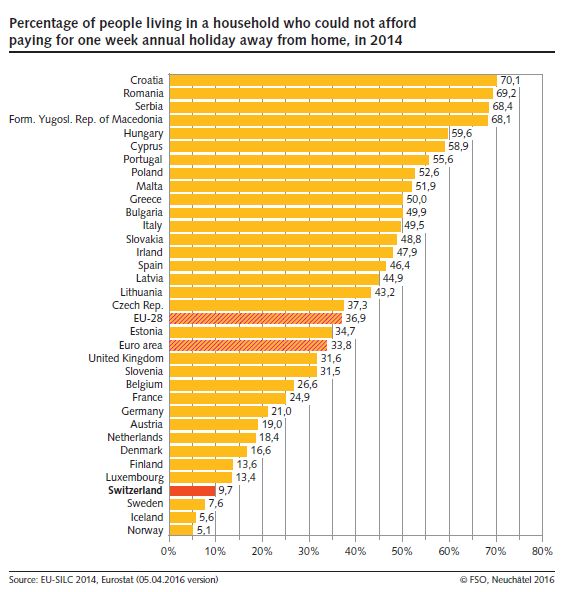25.04.2016 09:15 – Eurostat; FSO, Income, Consumption and Living Conditions (0353-1603-00) Standard of living in Switzerland remains one of the highest in Europe Neuchâtel, 25.04.2016 (FSO) – In 2014 Switzerland was one of the countries with the highest living standards in Europe. This does not exclude financial difficulties, as 6.6% of the population, i.e. approx. 530,000 people were affected by income poverty. Roughly one person in ten cannot afford a week’s holiday away from home according to the Federal Statistical Office’s survey on income and living conditions (SILC). Together with Norway and Luxembourg, the general standard of living in Switzerland continued to be amongst the highest in Europe in 2014. The general standard of living is measured by the median equivalised disposable income, after adjustment for differences in price levels between countries. In Switzerland this income was 1.7 times higher than that in Italy and 1.3 times higher than that in Germany or France. This means that despite the high price levels in Switzerland, the population’s financial situation, after deduction of obligatory expenditure, was more comfortable than that of its neighbouring countries and most countries in the European Union. Furthermore, people’s average level of satisfaction with their financial situation was the highest in Europe.
Topics:
Swiss Statistics considers the following as important: Featured, newsletter, Swiss Macro
This could be interesting, too:
Nachrichten Ticker - www.finanzen.ch writes Die Performance der Kryptowährungen in KW 9: Das hat sich bei Bitcoin, Ether & Co. getan
Nachrichten Ticker - www.finanzen.ch writes Wer verbirgt sich hinter der Ethereum-Technologie?
Martin Hartmann writes Eine Analyse nach den Lehren von Milton Friedman
Marc Chandler writes March 2025 Monthly
25.04.2016 09:15 – Eurostat; FSO, Income, Consumption and Living Conditions (0353-1603-00)
Standard of living in Switzerland remains one of the highest in Europe
Neuchâtel, 25.04.2016 (FSO) – In 2014 Switzerland was one of the countries with the highest living standards in Europe. This does not exclude financial difficulties, as 6.6% of the population, i.e. approx. 530,000 people were affected by income poverty. Roughly one person in ten cannot afford a week’s holiday away from home according to the Federal Statistical Office’s survey on income and living conditions (SILC).
Together with Norway and Luxembourg, the general standard of living in Switzerland continued to be amongst the highest in Europe in 2014. The general standard of living is measured by the median equivalised disposable income, after adjustment for differences in price levels between countries. In Switzerland this income was 1.7 times higher than that in Italy and 1.3 times higher than that in Germany or France. This means that despite the high price levels in Switzerland, the population’s financial situation, after deduction of obligatory expenditure, was more comfortable than that of its neighbouring countries and most countries in the European Union. Furthermore, people’s average level of satisfaction with their financial situation was the highest in Europe.
Income inequality comparatively low in Switzerland
In 2014, the ratio between the total income of the richest 20% and that of the poorest (the S80/S20 ratio) placed Switzerland’s income equality below the European average. In Switzerland, the total income of the richest 20% was 4.4 times higher than that of the poorest 20%, whereas in European average this was 5.2. The countries that showed the greatest inequalities in income distribution were Serbia (9.8), the former Yugoslavian republic of Macedonia (7.2), Romania (7.2) and Spain (6.8). The narrowest gap between the richest and poorest was in Iceland (3.1) and Norway (3.4).
Extremely disadvantaged living conditions for 4.6% of the population
In Switzerland, 4.6% of the population were living in material deprivation in 2014; this means that for this part of the population, their living conditions were greatly disadvantaged by a lack of financial resources. This rate is one of the lowest in Europe (18.6% in the EU). In Switzerland, the most common material deprivation was related to financial difficulties, such as not being able to meet an unexpected expense of CHF 2,500 within a month (21.6%).
Moreover, 9.7% of the population could not afford a week’s holiday away from home (36.9% European average). This rate increased to 22.6% for people living in a single parent family. 1.7% of people could not afford a full meal (meat, fish or vegetarian equivalent) every other day. Here too, the figure is low in European comparison (EU 9.5%).
6.6% of the Swiss population affected by poverty
In 2014 some 530,000 people (poverty rate 6.6%) were affected by income poverty as defined by standards for access to social assistance. Some 123,000 of these were employed persons (poverty rate 3.3%). The social groups most at risk of poverty were people living in a single parent family (14.1%), people who do not work (13.1%) and those without post-compulsory training or education (12.6%).
The poverty rate was also higher than average among people aged 65 and over (13.6%), particularly among old people living alone (22.7%). However, it should be noted that the poverty rate is calculated solely on the basis of income and does not consider financial assets. However, people aged 65 and over often draw on their savings to fund their outgoings.
More detailed information on poverty and deprivation can be found in the publication “Poverty and material deprivation, results from 2007 to 2014” ![]() .
.
Download this press release (pdf, 174 KB)

